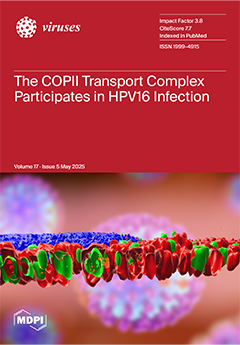Enteric viruses, such as the Aichi virus (AiV), pose a potential health risk due to their high excretion rates through fecal elimination, limited removal during treatment processes, and prolonged survival, highlighting the need to assess the potential for exposure and disease transmission through
[...] Read more.
Enteric viruses, such as the Aichi virus (AiV), pose a potential health risk due to their high excretion rates through fecal elimination, limited removal during treatment processes, and prolonged survival, highlighting the need to assess the potential for exposure and disease transmission through sanitation systems. This study investigated the prevalence of AiV at three key stages of sewage treatment in the city of São José do Rio Preto, São Paulo state, Brazil, as well as its viral concentrations, infectious potential, and molecular characterization. The data were also analyzed for potential correlations with reported diarrheal disease cases in the city and the physicochemical properties of sewage. The methodology employed included Nested PCR, qPCR, Sanger Sequencing, and phylogenetic analysis, as well as infectivity testing in cell cultures. The prevalence of AiV throughout the year in raw sewage samples was 90.4%, 78.8% in post-anaerobic biological treatment, and 71.1% in post-chemical treatment, totaling 125 positive samples out of 156, being characterized as AiV genotype A. The virus also demonstrated persistence and infectious potential at all three stages analyzed. The AiV-A mean concentration ranged from 2.05 log
10 to 4.64 GC/mL, 2.31 to 4.72 log
10 GC/mL, and 2.13 to 2.85 log
10 GC/mL for the same treatment stages, respectively. A significant difference (
p ≤ 0.05) suggests higher viral concentrations in summer at the three sewage process points analyzed, while lower viral concentrations were observed in post-chemical treatment samples (
p ≤ 0.01). Additionally, no statistically significant relationship was observed between the virus occurrence in samples and cases of acute diarrheal diseases in the city. In conclusion, this study highlights that much remains to be understood about AiV while providing valuable insights into the relationship between AiV, environmental factors, and public health.
Full article






